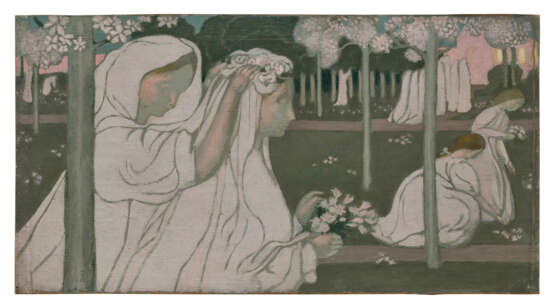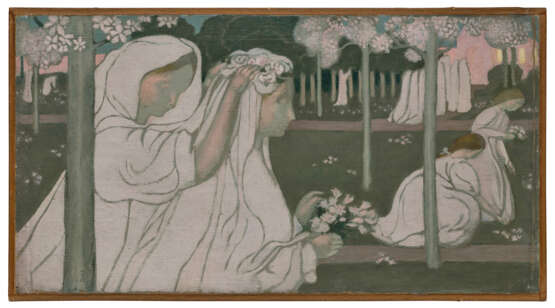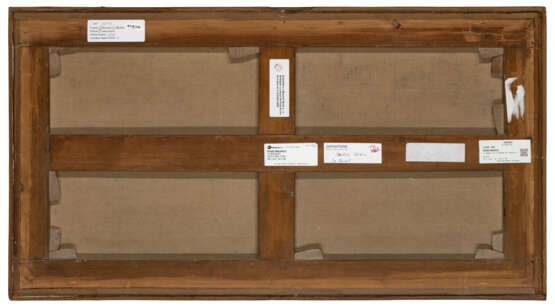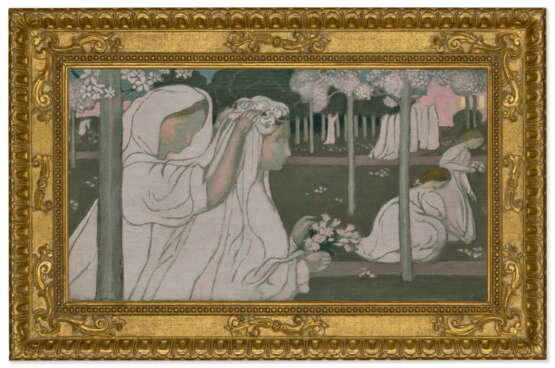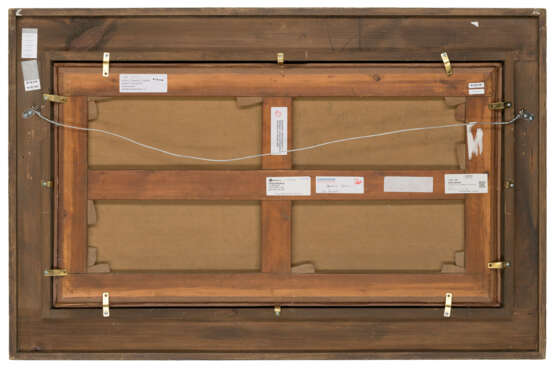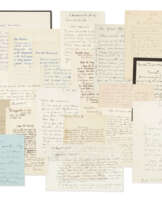ID 1051698
Лот 106 | Maurice Denis (1870-1943)
Оценочная стоимость
€ 280 000 – 350 000
Jeunes filles en blanc ou Communiantes, 1er panneau de 'Frauenliebe und Leben', frise pour une chambre à coucher
monogrammé (en bas gauche)
huile sur toile
51 x 93.5 cm.
Peint en 1895
signed with the monogram (lower left)
oil on canvas
21 1⁄8 x 36 7⁄8 in.
Painted in 1895
Provenance
Siegfried Bing, Paris (commandé auprès de l'artiste en 1895 pour le Salon de l'Art Nouveau).
Maurice Denis, Paris (acquis auprès de celui-ci).
Ambroise Vollard, Paris (acquis auprès de celui-ci fin 1903-début 1904).
Collection de Galéa, France (par descendance); vente, Me Bellier, Paris, 8 novembre 1940, lot 45.
Baron Henri Marie Petiet, France (acquis au cours de cette vente).
Mélanie Rouat, Riec-sur-Bélon (avant 1955).
Collection particulière.
Vente, Mes Thierry et Lannon, Brest, 10 décembre 2000, lot 146 (titré 'Les Communiantes - La promenade au jardin').
Sam Josefowitz, Pully (acquis au cours de cette vente).
Puis par descendance aux propriétaires actuels.
Literature
H. Nostitz, Aus dem alten Europa, Menschen und Städte, Leipzig, 1926, p. 175.
Maurice Denis, Journal, 1884-1904, Paris, 1957, vol I, p. 112 et 225 et vol. II, p. 110.
G. Schuster et M. Pehle, Harry Graf Kessler, Tagebuch eines Weltmannes, cat. exp., Deutschen Literaturarchivs im Schiller-Nationalmuseum, Marbach am Neckar, 1988, p. 215, no. 18.
F. Becker et U. Thieme, Allgemeines Lexikon der bildenden Künstler von der Antike bis zur Gegenwart, Delaulne – Dubois, Leipzig, 1992, vol. IX, p. 69.
J.-P. Bouillon, Maurice Denis, Genève, 1993, p. 70.
C. Schäfer, Maurice Denis et le comte Kessler (1902-1913), Francfort, Berlin, Berne, New York, Paris et Vienne, 1997, p. 178-179, no. 5.
'Peinture sacrée' in La Gazette, Paris, 15 décembre 2000, No. 45, p. 76 (illustré; titré 'Les Communiantes, La promenade au jardin').
G. Groom, Beyond the Easel, Decorative Painting by Bonnard, Vuillard, Denis, and Roussel, 1890-1930, cat. exp., The Art Institute of Chicago, Chicago et The Metropolitan Museum of Art, New York, 2001, p. 99, fig. 1(d) (titré 'Bouquet').
Exhibited
Paris, Galerie Samuel Bing, Salon de l’Art Nouveau, décembre 1895-janvier 1896, no. 71.
Paris, Musée d'Orsay; Montréal, Musée des Beaux-Arts de Montréal et Rovereto, Museo di Arte Moderna e Contemporanea di Trento e Rovereto, Maurice Denis, Earthly Paradise, octobre 2006-septembre 2007, p. 241, no. 97 (illustré en couleurs, p. 240; titré ‘Bouquet [Girls in White]’).
Pont-Aven, Musée Maurice Denis, Maurice Denis et la Bretagne, juin-octobre 2009, p. 145 no. PA.30 (illustré en couleurs, p. 8).
Lausanne, Musée cantonal des Beaux-Arts, Maurice Denis, Amour, 1888-1914, février-mai 2021, p. 138, no. 46 (illustré en couleurs, p. 139; titré 'Le Bouquet [Jeunes Filles en blanc]').
Further details
Évocation des âges de la vie, ode à l’amour, chant d’espérance, hommage à Marthe, son épouse musicienne et chanteuse accomplie, ce cycle est comme un poème déployé en frise.
Jeunes Filles en blanc de Maurice Denis appartient au cycle décoratif «L’Amour et la vie d’une femme», inspiré des huit lieder de Robert Schumann, composés en 1840 sur des poèmes d’Adelbert von Chamisso. Ce cycle, ornement pour une chambre à coucher, est dès l’origine conçu par Maurice Denis pour être présenté, en décembre 1895, chez Siegfried Bing pour l’inauguration de sa galerie à l’enseigne de «L’Art Nouveau». Marchand au goût très sûr, Bing avait également commandé pour l’occasion aux Nabis des cartons de vitraux qui seront exécutés par Louis-Comfort Tiffany. Bing avait même imaginé d’accompagner les toiles de Denis de meubles d’Émile Gallé, ce que le peintre refusa. Ce «Chemin de la vie» pour reprendre le titre que Denis donne au vitrail qu’il imagine en 1896 pour Denys Cochin en reprenant des motifs du cycle Bing, est ensuite dispersé en une histoire dont les contours sont aujourd’hui bien connus grâce aux recherches de Fabienne Stahl (catalogue Les Nabis & le décor, Paris, 2019). Si Denis vend certaines toiles à des amis et à des collectionneurs fidèles (Gabriel Trarieux, Adrien Mithouard), Jeunes Filles en blanc est acquise, avec quatre autres toiles du cycle, par le célèbre marchand Ambroise Vollard. Tandis que certaines sont par la suite achetées par le comte Harry Kessler pour orner sa demeure de Weimar, Jeunes Filles en blanc a une autre destinée: acquise par le baron Petiet, le plus grand collectionneur français d’estampes au XXe siècle, elle passe ensuite dans la collection de Mélanie Rouat (1878-1955), dont le restaurant de Riec-sur-Belon, faisait l’admiration de Curnonsky (1872-1956), romancier et célèbre critique culinaire baptisé «Prince des gastronomes». Un historique de légende!
Gilles Genty
An evocation of the ages of life, an ode to love, a song of hope, a tribute to Marthe, his wife, an accomplished musician and singer, this cycle may be likened to a poem in the form of a frieze.
Jeunes Filles en blanc, by Maurice Denis, is part of the decorative cycle “L’Amour et la vie d’une femme”, inspired by the eight Lieders by Robert Schumann, composed in 1840, around poems by Adelbert von Chamisso. This cycle, a decoration for a bedroom, was originally designed by Maurice Denis to be presented in December 1895 at the Siegfried Bing gallery for its inauguration under the banner of “Art Nouveau”. A dealer with impeccable taste, Bing also ordered stained glass panels from the Nabis for the occasion, which would be produced by Louis-Comfort Tiffany. Bing even imagined accompanying the paintings of Denis with furniture by Émile Gallé, which the painter refused. This “Chemin de la Vie”, to use the title that Denis gave to the stained glass window that he designed in 1896 for Denys Cochin, using motifs from the Bing cycle, is then dispersed into a story whose outlines are well understood today, thanks to the research by Fabienne Stahl (Les Nabis & le décor catalogue, Paris, 2019).While Denis sold certain paintings to friends and loyal collectors (Gabriel Trarieux, and Adrien Mithouard), Jeunes Filles en blanc was acquired, along with four other paintings from the cycle, by the reknowned art dealer Ambroise Vollard. While certain pieces were subsequently purchased by Count Harry Kessler to adorn his home in Weimar, Jeunes Filles en Blanc had another fate: acquired by Baron Petiet, the most significant French collector of prints in the 20th century, it then passed into the collection of Mélanie Rouat (1878-1955), whose restaurant in Riec-sur-Belon was admired by Curnonsky (1872-1956), the novelist and famous culinary critic, baptised the “Prince of gastronomes” - a truly legendary story!
Gilles Genty
Maurice Denis et la Frise Bing
Pour l'ouverture de sa nouvelle galerie L'Art Nouveau, le marchand d'art Siegfried Bing commande plusieurs œuvres décoratives aux Nabis, qu'il avait déjà sollicités l'année précédente pour réaliser des cartons de vitraux exécutés par Tiffany.
Au rez-de-chaussée, le point fort de la visite est le salon en rotonde orné par Albert Besnard, près duquel sont exposés les cinq panneaux composant L'Album d'Édouard Vuillard. Le premier étage compte trois pièces conçues par Henry Van de Velde : au centre une salle à manger (avec des panneaux de Paul Ranson et des assiettes en porcelaine de Vuillard, desservant un cabinet de l'amateur et un fumoir), un boudoir avec des peintures sur soie de Charles Conder, et une chambre à coucher décorée par Maurice Denis.
Le thème retenu pour ce dernier ensemble - on ne sait s'il fut proposé par le peintre ou suggéré par le commanditaire - est Frauenliebe und Leben (1840), cycle de huit lieder de Robert Schumann sur des poèmes d'Adelbert von Chamisso […]. L'inspiration schumanienne, à commencer par le Dichterliebe […] (Les Amours du poète), est intimement liée pour Denis à l'éclosion de son amour pour Marthe Meurier: elle-même pianiste, elle interprétait L'Amour et la vie d'une femme, dans sa traduction française d'Amédée Boutarel.
Loin d'être une illustration littérale des mélodies, cette frise est essentiellement « le développement pictural d'une thématique toute personnelle » (J.-P. Bouillon, Maurice Denis, Paris, 1993, p. 70). Servie par une palette réduite composée d'une harmonie de couleurs mates (roses, mauves, violets), elle est peinte avec une économie de moyens plastiques remarquable, signe des efforts de simplification, de pureté du peintre, alors attaché à la naïveté des Primitifs et au classicisme d'un Puvis de Chavannes.
L'essentiel des panneaux, aujourd'hui disparus, n'est connu que par des reproductions anciennes[…]. En l'absence de documents photographiques de la chambre in situ, l'ordre des sections de cette frise est longtemps resté incertain […]. La chambre, d'un beau volume (environ 25 m²) faisait 4,10 m de large et environ 6 m de long, avec 3 m de hauteur sous plafond et deux fenêtres. La frise peinte, accrochée sous le plafond, se composait de sept panneaux de même hauteur, mais de largeur variable pour épouser les aménagements intérieurs (cheminée avec miroir, lit, armoire). Sur le mur de gauche, les trois premiers panneaux présentaient la vie de la jeune fille: [la présente œuvre] Jeunes filles en blanc (49 × 92 cm.), Jeune fille à sa toilette (49 × 34 cm. [vendu chez Christie’s, Paris, 5 avril 2023, lot 134 ]) et La Farandole, le plus long de cette première section. Sur le mur du fond, le lit en 140 était encadré symétriquement par deux panneaux de mêmes dimensions (49 × 135 cm.): Les Fiançailles et Le Mariage. Sur le mur de droite enfin, se déployait la vie de l'épouse, en deux longs panneaux: La Naissance (49 × 200 cm.) et La Maternité (49 × 180 cm.).
Siegfried Bing, qui supervisait l'aménagement des différents espaces, était préoccupé d'harmoniser l'ameublement avec les lignes et les couleurs de la frise peinte préparée par Denis […]; il lui proposa des meubles d'Émile Gallé, refusés par le peintre qui préféra dessiner lui-même les pièces de mobilier dont il confia l'exécution à Eugène Pinte. Résultat sans appel lors de l'inauguration: l'ensemble ne plaît pas, les réactions négatives de la critique sont unanimes, et Bing demande à Denis de venir récupérer ses peintures et pièces d'ameublement au plus tôt. Ainsi, la frise sur laquelle l'artiste avait travaillé de longs mois ne fut présentée au public que quinze jours...
Une fois essuyé cet échec, Denis aurait certainement préféré une «vente en bloc » [Lettre de Gabriel Trarieux à Denis, 11 février 1896] pour que la cohérence de l'ensemble soit conservée. Il se résout pourtant à se séparer de La Farandole, vendue 700 francs à son ancien condisciple de Condorcet, Gabriel Trarieux, ainsi que de la Jeune fille à sa toilette, cédée l'année suivante à Adrien Mithouard (pour 300 francs). Quant aux cinq panneaux restant de la frise, Denis les conserva dans son atelier jusqu'à leur vente en 1903 à Ambroise Vollard, auprès duquel le comte Kessler en fera l'acquisition (C. Schäfer, Maurice Denis et le comte Kessler, Francfort, 1997, p. 65, 79-80, 178-179, 206) […].
F. Stahl, in Les Nabis et le décor, Bonnard, Vuillard, Maurice Denis..., cat. exp., Musée de Luxembourg, Paris, 2019, p. 174.
Maurice Denis and the Bing Frieze
For the opening of his new gallery, L'Art Nouveau, art dealer Siegfried Bing commissioned several decorative works from the Nabis, whom he had already asked the previous year to create cartoons for stained-glass windows designed by Tiffany.
On the ground floor, the highlight of the visit is the rotunda lounge decorated by Albert Besnard, next to which are displayed the five panels making up L'Album by Édouard Vuillard. The first floor comprises of three rooms designed by Henry Van de Velde: at the centre, a dining room (with panels by Paul Ranson and porcelain plates by Vuillard, serving an amateur's cabinet and a smoking room), a boudoir with silk paintings by Charles Conder, and a bedroom decorated by Maurice Denis.
The theme allocated to this ensemble - whether it be the painter’s decision or the client’s suggestion -– is known as Frauenliebe und Leben (1840), a cycle of eight lieder by Robert Schumann based on poems by Adelbert von Chamisso [...]. For Denis, Schumann's inspiration, starting with the Dichterliebe [...] (The Poet's Loves), was closely linked to the blossoming of his love for Marthe Meurier: herself a pianist, she performed L'Amour et la vie d'une femme (The Love and Life of a Woman), in the French translation by Amédée Boutarel.
Far from being a literal illustration of the melodies, this frieze is essentially "the pictorial development of an entirely personal theme" (J.-P. Bouillon, Maurice Denis, Paris, 1993, p. 70). Using a sobre palette composed of a harmony of matt colours (pinks, mauves, violets), it is painted with a remarkable economy of plastic means, indicating the painter's efforts to simplify and purify his compositions, at a time he adhered to the Primitives’ naivety and Puvis de Chavannes’ classicism.
Most of the panels, which have now disappeared, are known only through old reproductions [...]. In the absence of photographic documentation of the room in situ, the order of the sections of this frieze has long remained uncertain [...]. The large room (around 25 m²) was 4.10 m wide and around 6 m long, with a 3 m high ceiling and two windows. The painted frieze hanging below the ceiling was made up of seven panels of the same height, but varying in width to match the interior fittings (fireplace with mirror, bed, wardrobe). On the left-hand wall, the first three panels depicted the life of the young girl: Jeunes filles en blanc (49 × 92 cm.) [the present work], Jeune fille à sa toilette (49 × 34 cm. [sold at Christie's, Paris, 5 April 2023, lot 134]) and La Farandole, the longest of this first section. On the back wall, the 140 cm. bed was symmetrically framed by two panels of the same dimensions (49 × 135 cm.): Les Fiançailles and Le Mariage. On the right-hand wall, the wife’s life was depicted in two long panels: La Naissance (49 × 200 cm.) and La Maternité (49 × 180 cm.).
Siegfried Bing, who supervised the layout of the various spaces, was concerned in ensuring that the furnishings harmoniously fitted with the lines and colours of the painted frieze prepared by Denis [...]; he suggested furniture by Émile Gallé, which was rejected by the painter, who preferred to design the pieces himself and entrust Eugène Pinte with their execution. The result was clear at the inauguration: the ensemble was not to his liking, the critics were unanimous in their negative reactions, and Bing asked Denis to come and collect his paintings and pieces of furniture as soon as possible. As a result, the frieze on which the artist had worked for months was only presented to the public for a fortnight...
Once this setback had been overcome, Denis would certainly have preferred a "block sale" [Letter from Gabriel Trarieux to Denis, 11 February 1896] to preserve the coherence of the whole. He nevertheless decided to part with La Farandole, sold for 700 francs to his former Condorcet classmate Gabriel Trarieux, as well as La Jeune fille à sa toilette, sold the following year to Adrien Mithouard (for 300 francs). As for the five remaining panels of the frieze, Denis kept them in his studio until they were sold in 1903 to Ambroise Vollard, from whom Count Kessler acquired them (C. Schäfer, Maurice Denis et le comte Kessler, Frankfurt, 1997, pp. 65, 79-80, 178-179, 206) [...].
F. Stahl, in Les Nabis et le décor, Bonnard, Vuillard, Maurice Denis..., exh. cat., Musée de Luxembourg, Paris, 2019, p. 174.
| Автор: | Морис Дени (1870 - 1943) |
|---|---|
| Техника исполнения: | Масло на холсте |
| Категория аукционного дома: | Картины |
| Автор: | Морис Дени (1870 - 1943) |
|---|---|
| Техника исполнения: | Масло на холсте |
| Категория аукционного дома: | Картины |
| Адрес торгов |
CHRISTIE'S 9 Avenue Matignon 75008 Paris Франция | ||||||||||||||
|---|---|---|---|---|---|---|---|---|---|---|---|---|---|---|---|
| Предосмотр |
| ||||||||||||||
| Телефон | +33 (0)1 40 76 85 85 | ||||||||||||||
| Факс | +33 (0)1 40 76 85 86 | ||||||||||||||
| Условия использования | Условия использования | ||||||||||||||
| Транспортировка |
Почтовая служба Курьерская служба Самовывоз | ||||||||||||||
| Способы оплаты |
Банковский перевод | ||||||||||||||
| Часы работы | Часы работы
|
